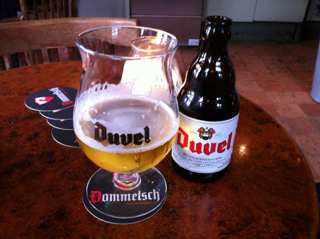[quote author=Duvelonline]
Mashing
Aside from water, beers chief ingredient, barley is the primary raw material. The barley has to germinate for five days in the maltworks before being dried with hot air. This results in malt. The colour of the malt and consequently, of the beer as well, is determined by the temperature. In the brewing hall we mix the ground malt with the brewing water that is drawn from our own sources. We have four 60m-deep wells. This mixture of water and malt, the mash, is brought to various temperatures in a series of steps. The enzymes that are formed during germination further break down the starch in the malt into fermentable sugars. Through filtration, the solids (draff) are separated from the liquid sugar extract (wort). During the cooking process, we add various types of hops which give the beer its characteristic bitterness and pleasing aromas. For the hops our brewers select only the best aromatic varieties, Saaz-Saaz from the Czech Republic and Styrian Golding from Slovenia. After the hops are removed and the mixture is processed in the whirlpool, it is allowed to cool and the beer extract is pumped into the fermentation vessels.
Primary Fermentation Day 2 to 8
The Duvel then ferments and ripens a first time in refrigerated cylinder/conical tanks for some 20 days. We work exclusively with our own top-fermentation strain of yeast (Saccharomyces cerevisiae cerevisiae). According to the top fermentation principle, at the end of the fermentation process, the yeast floats to the top of the young beer where it forms a thick layer of foam. This process takes place at a temperature of 20° to 26° Celsius over a period of 4 to 8 days.
Lagering Day 8 to 29
After the primary fermentation comes the lagering or maturing phase in the lager tanks, where the beer is chilled to -2° Celsius in order to allow it to gently continue to ferment. During this phase, which is carefully monitored with daily analyses and tasting, the beer acquires its balanced flavour and it develops its rich aromatic bouquet. After filtering, the beer is ready to be bottled.
Day 30: Bottling
Right before bottling, an extra dose of fermentable sugars is added along with active yeast cells, which leads to a secondary fermentation in the bottle.
Day 33-47: 2 weeks maturing in warm cellars
By adding a small dose of fermentable sugars and extra yeast to the beer, we cause it to undergo an extra, secondary fermentation in the bottle. This process gives the beer a richer aroma and a more full-bodied taste. This secondary fermentation takes place at a temperature of 22° Celsius in the warm cellars where the beer matures for 14 days.
Day 48-90: 6 weeks maturing in cold cellars
After that, the beer is allowed to rest in cold cellars, where it continues to mature for another 6 weeks (42 days) at a temperature of 5° to 6° Celsius. The cold cellars have a maximum capacity of 12 million bottles. The cool temperature refines the flavour and gives the beer a riper aroma. In other words, the entire production process actually takes
3 months from start to finish. Preparing a traditional beer of perfect quality takes time, lots of time.[/quote]
Ser fortsatt på å forsøke meg på denne. Er det hensiktsmessig for en hjemmebrygger å følge denne fremgangsmåten best mulig temperaturmessig?


